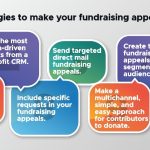Introduction
A nonprofit gala is more than just a fundraising event—it’s an opportunity to connect with donors, raise awareness, and celebrate your organization’s impact. A well-planned gala can attract major donors, build community support, and maximize fundraising success. However, organizing a successful event requires careful planning and strategic execution.
Here are five essential tips to help you plan a better nonprofit gala and create a memorable experience for your attendees.
1. Set Clear Goals and Objectives
Before diving into event planning, it’s crucial to define your gala’s purpose and goals.
Key Questions to Ask:
✅ What is the primary objective? (e.g., fundraising, donor appreciation, brand awareness)
✅ How much money do you need to raise? (Set a realistic financial target)
✅ Who is your target audience? (Major donors, corporate sponsors, community members)
✅ What experience do you want attendees to have? (Elegant dinner, inspiring program, interactive activities)
Example Goal:
“Our goal is to raise $100,000 to fund scholarships for 50 students. We aim to attract 200 guests, engage 10 corporate sponsors, and increase recurring donations by 20%.”
Why It Works:
Setting clear goals helps guide decision-making, ensuring that every aspect of the event aligns with your mission and fundraising objectives.
2. Choose the Right Venue and Theme
Your venue and theme set the tone and atmosphere of the gala. Choose a location and concept that align with your nonprofit’s mission and appeal to your target audience.
Venue Selection Tips:
✅ Consider accessibility – Choose a location that is easy to reach and accommodates all guests.
✅ Ensure capacity and amenities – The venue should comfortably fit your expected attendees and provide necessary facilities (stage, AV equipment, catering).
✅ Look for sponsorship opportunities – Some venues may offer discounts or donations for nonprofits.
Popular Nonprofit Gala Themes:
🎭 Masquerade Ball – Elegant and mysterious, perfect for high-end fundraising.
🌿 Garden Gala – Ideal for environmental or nature-focused nonprofits.
🎶 A Night of Music & Arts – Great for supporting arts education or cultural programs.
🏆 Impact Awards Night – Celebrate outstanding donors, volunteers, or beneficiaries.
Why It Works:
A well-chosen venue and theme enhance the overall guest experience, making the event more enjoyable and memorable.
3. Secure Sponsorships and Partnerships
Corporate sponsorships can significantly offset costs and increase fundraising potential. Partnering with businesses also helps expand your nonprofit’s reach and credibility.
How to Attract Sponsors:
✅ Create a sponsorship package outlining benefits (e.g., logo placement, VIP seating, social media recognition).
✅ Offer tiered sponsorship levels (Platinum, Gold, Silver) to accommodate different budgets.
✅ Reach out to businesses that align with your mission (e.g., a food bank partnering with grocery chains).
✅ Acknowledge and thank sponsors publicly to strengthen relationships.
Example Sponsorship Offer:
“As a Gold Sponsor ($5,000), your company will receive a VIP table, recognition in our program, social media promotion, and a speaking opportunity at the gala.”
Why It Works:
Sponsorships create mutual benefits—your nonprofit receives funding, while businesses gain positive brand exposure and community goodwill.
4. Plan an Engaging Program and Fundraising Activities
A successful gala keeps guests engaged and motivated to donate. The program should balance inspiration, entertainment, and fundraising opportunities.
Essential Gala Program Elements:
✅ Welcome Speech – Express gratitude and set the event’s tone.
✅ Impact Storytelling – Share personal stories of beneficiaries to create an emotional connection.
✅ Fundraising Appeals – Include live auctions, donation pledges, or raffle draws.
✅ Entertainment – Live music, performances, or keynote speakers can enhance the experience.
✅ Award Recognition – Honor donors, volunteers, or key supporters.
Fundraising Activity Ideas:
🎤 Live or Silent Auction – Offer exclusive experiences or high-value items.
💳 Paddle Raise (Fund-a-Need) – Ask guests to raise their paddles to pledge donations at different levels.
🎟 Raffle Draw – Sell tickets for a chance to win prizes.
📱 Mobile Giving – Use text-to-donate or online giving platforms for easy contributions.
Why It Works:
A dynamic program keeps attendees engaged while providing multiple ways to contribute to your cause.
5. Follow Up and Express Gratitude
The gala doesn’t end when the last guest leaves. A strong follow-up strategy helps build long-term relationships with attendees and encourages future giving.
Post-Event Follow-Up Checklist:
✅ Send thank-you emails or letters to guests, donors, and sponsors.
✅ Share event highlights on social media with photos, videos, and testimonials.
✅ Provide an impact report showing how funds raised will be used.
✅ Ask for feedback through post-event surveys to improve future galas.
✅ Encourage ongoing support by inviting attendees to join recurring donation programs or future events.
Example Thank-You Message:
“Thank you for making our gala a success! Together, we raised $120,000 to support families in need. Your generosity makes a lasting impact. Stay connected with us for future updates! [Website link]”
Why It Works:
A thoughtful follow-up strengthens donor relationships and keeps supporters engaged for future fundraising efforts.
Conclusion
Planning a nonprofit gala requires careful coordination, but with the right strategy, it can be a powerful fundraising and engagement tool. By setting clear goals, selecting the perfect venue and theme, securing sponsorships, planning an engaging program, and following up with attendees, you can maximize donations, create a memorable experience, and build lasting relationships with supporters.
With these five tips, your nonprofit can host a successful gala that not only raises funds but also inspires long-term commitment to your mission.


